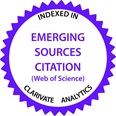Tytuł
Struktury gron (klastrów) przemysłowych - multigrono - pasmo
Abstract
There is a growing interest among researchers and politicians in the mechanisms of the emergence and development of clusters, which makes it possible to intensify the economic development of the region in which a cluster is located; to increase the region's competitiveness and entrepreneurship. A cluster also increases effectiveness of utilizing public aid for non-public entities, including aid funds from the European Union. Clusters in Poland, as compared to the old EU members, are poorly developed; state administration and local government units continue to show insufficient interest in them. This interest is likely to grow if benefits from the development of clusters are evidenced. The ceramic tile cluster of Końskie - Opoczno - Przysucha - Tomaszów Mazowiecki and the metallurgical cluster of Piotrków Trybunalski - Końskie - Kielce - Starachowice - Ostrowiec Świętokrzyski are examples of underused opportunities. Theses clusters were studies by a group of researchers from the Management Institute at the Świętokrzyska Academy in Kielce. The findings of the research show that within the District of Końskie there are organizations belonging to two different clusters: the ceramic tile cluster and the metallurgical cluster. One may say that Końskie is the territory of a quasi-bicluster. It seems that there are such organizational structures which resemble multiclusters, i.e. clusters of entities belonging to different industry sectors, located at one place and sometimes making use of services of common functional organizations (e.g. consulting and advertising agencies that render services for companies from different industry sectors). Potentially, Upper Silesia and Zagłębie are such regions in Poland. However this is to be verified in the course of scientific researches. A special type of tie in a group of organizations is a possibility of establishing a zone i.e. a spatial concentration of 2, 3 or more multiclusters. A possible example of such a zone could be a concentration of organizations along the Wroclaw-Katowice-Krakow Motorway, where automotive, IT, medical clusters can be found, and potentially many others. This fact, utilized accurately through management tools (e.g. local entrepreneurship development, increase in competitiveness etc.), may facilitate the revitalization of Upper Silesia and Zagłębie owing to a positive impact on the development of multiclusters in that region: the multiclusters in Krakow and Wroclaw.
Abstrakt
Wśród badaczy i polityków wzrasta zainteresowanie mechanizmami powstawania i rozwoju gron (klastrów), stwarzających możliwość intensyfikacji rozwoju gospodarczego, poprawy konkurencyjności i wzrostu przedsiębiorczości w regionie, w którym są zlokalizowane. Istnienie grona podnosi też efektywność wykorzystania środków pomocy publicznej dla podmiotów niepublicznych, w tym środków pomocowych Unii Europejskiej. Grona w Polsce są w porównaniu ze starymi krajami Unii Europejskiej słabo rozwinięte, nadal też niedostateczne jest zainteresowanie nimi władz państwowych i jednostek samorządu terytorialnego. Wzrostowi zainteresowania sprzyjać winno ukazanie korzyści z rozwoju gron. Przykładem takich niewykorzystanych możliwości jest grono płytek ceramicznych Końskie - Opoczno - Przysucha - Tomaszów Mazowiecki i grona odlewniczego Piotrków Trybunalski - Końskie - Kielce - Starachowice - Ostrowiec Świętokrzyski, które były badane przez zespół pracowników Instytutu Zarządzania Akademii Świętokrzyskiej w Kielcach. W toku badań ustalono, iż na terenie powiatu koneckiego zlokalizowane są organizacje wchodzące w skład dwóch różnych gron: grona płytek ceramicznych i grona odlewniczego. Można powiedzieć, iż Końskie jest terenem funkcjonowania quasi bigrona. Wydaje się, iż istnieją takie struktury organizacyjne, które mają charakter multigron, a więc gron przedsiębiorstw należących do różnych sektorów produkcyjnych, zlokalizowanych w jednym miejscu i korzystających niekiedy z wspólnych organizacji funkcjonalnych (np. firmy doradcze, promocyjne itp. obsługujące firmy z różnych sektorów produkcyjnych). Potencjalnie takim regionem w Polsce jest Górny Śląsk i Zagłębie, co oczywiście należy zweryfikować w toku badań naukowych. Szczególnym rodzajem więzi grupy organizacji jest możliwość ukształtowania się pasma, tj. przestrzennego skupiska 2-3 i ewentualnie większej liczby multigron. Potencjalnym przykładem takiego pasma może być skupisko organizacji wzdłuż autostrady Wrocław - Katowice - Kraków, gdzie prawdopodobnie istnieją grona przemysłu motoryzacyjnego, informatycznego, grona usług medycznych i być może inne ich rodzaje. Fakt ten - właściwie wykorzystany poprzez użycie instrumentów menedżerskich (np. rozwój przedsiębiorczości lokalnej, generowanie wzrostu konkurencyjności itp.) - może ułatwić rewitalizację Górnego Śląska i Zagłębia dzięki korzystnemu wpływowi na rozwój multigrona tamże multigron w Krakowie i Wrocławiu.
Recommended Citation
Olesiński, Z. (2006). Organizational structures of industrial clusters: multicluster and zone. Problemy Zarządzania, 4(13), 167-179. Retrieved from https://press.wz.uw.edu.pl/ems/vol4/iss13/11
First Page
167
Last Page
179
Page Count
12
Publisher
University of Warsaw








